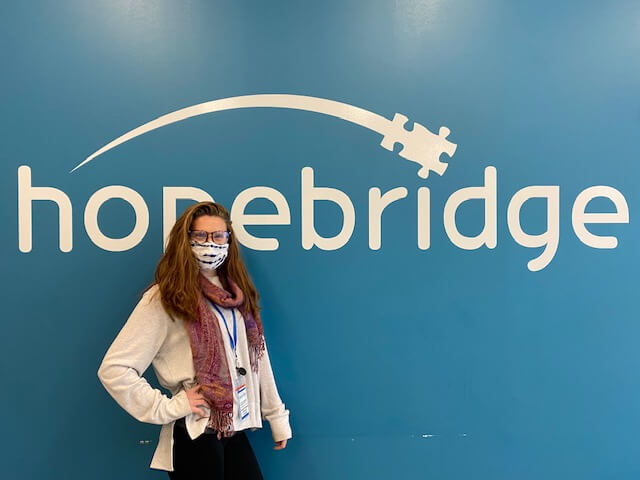

With a new year often comes new resolutions and intentions, but at Hopebridge, we never stop setting them. Rather than approaching them one time a year, we work with our families to set, reevaluate and achieve goals year-round.
There is a science, and some might say an art form, to setting goals with autism. Our Board Certified Behavior Analysts (BCBA) are educated and trained in working with caregivers to create personalized plans that reflect each individual child’s and family’s goals.
Our clinicians have extensive experience building short-term to long-term goals for children with autism spectrum disorder (ASD). We connected with our team of BCBAs to share some of the top tips for parents who want to play an active role in goal-setting for their children who participate in applied behavior analysis (ABA therapy).

Parents play a key role in ABA therapy, especially at Hopebridge. In our centers, we collaborate with our patients’ caregivers from the start, plus continue to check in and discuss the programs of care during ongoing parent training sessions. A crucial piece of these plans and sessions centers around goals.
How can you work with your BCBA to set up your child for success? Here are some recommended steps and considerations to approaching measurable, achievable goals from the start.

Once caregivers and the therapy team have an idea of where we want the child headed, the BCBA will create a step-by-step process of how to get there. Sometimes these initial pieces can seem to caregivers like we’re not doing much in therapy, but in reality, we are taking baby steps toward a bigger end goal. These smaller steps can be critically foundational and parents may not realize how much they tie into each other until the individual is much older.
When building out short-term goals for children with autism, caregivers should take a step back and look at the day-to-day routine. Think about what skills the child is not doing that they and your family could truly benefit from them starting to do.
Some ideas include independent dressing, putting clothes away, feeding oneself and showering oneself. There are also chores that kids as young as 3 years old can help with around the house. These are quick goals we can teach them in the center and then transfer immediately to the home. They help increase independence, plus the family has something taken off their plate. Everyone is reinforced by this skill because it’s one-and-done.
When it comes to long-term, parents should think about the future and their end goal. If the child is 3 years old, what is your goal for 5 years old? Maybe it is homeschooling, half-day kindergarten or full-time kindergarten. We will then start piecing together strings and sets of short-term goals together to build up to the long-term goal. Depending on the objective, at 3 years of age, we can start teaching the child how to participate in circle time, sit at a desk, tie shoes, follow directions, participate in a group and get in line.
Whether short-term or long-term, having these goals helps a BCBA with the overall program. I like to reach out to families and let them know what I see as immediately urgent, then find out whether they agree or if something else should come first. Buy-in from the parents is necessary.
Decreasing maladaptive behaviors is usually a main goal of ABA, so we did not touch on them much here, but when building out goals, think about behaviors that are of high concern and dangerous. It is important to place effort on elopement, physical aggression, self-injury and PICA first, versus those others may just find “different” but do not pose immediate harm to anyone. Aggression may not seem urgent at 3 years old, but all of a sudden, the child will be 6 and a lot bigger and stronger, so if it’s not handled early, it will become a larger issue. These types of reduction goals should always take priority over something like a child repetitively asking to go to the store.
What does goal-setting look like as part of a real ABA program?
Some of our team worked with one child who took part in varying amounts of elopement. He began to experience a lot of changes at home, from his parents fostering an infant, to quarantining during the COVID-19 pandemic. This is when his elopement in the home began to escalate, and eventually, he ran away from his older sister in the grocery store, which was a big deal.
His parents and BCBA sat down to talk about it. They discussed what it looks like when he elopes, how it happens, what they do when it happens, and how other family members react. Based on this conversation, they were able to put some short-term goals in place.
First, they decided everyone in the family needs instructional control, meaning he knows that when someone tells him to stop, he needs to stop. As part of the program, they practiced playing a stop-and-go game in their backyard. When he stopped, they would run to give him a preferred toy or pick him up and spin him around as reinforcement. This way, not only did he learn to listen to his trusted adults and siblings, but he also knows good things happen when he listens.
They created another short-term goal around hand-holding. Originally, when he would hold his sister’s hand, he would fall to the ground. When she bent down to pick him up, he’d take off running. The team worked on tolerating handholding for varying amounts of time, starting at 30 seconds, one minute, and then moving their way up.
Ultimately, these short-term goals were all directly related to this child’s long-term goal of reducing and eliminating elopement.
What are your hopes for your child? Where do you see them in the future, and how can we work with your family to get there?Through ABA therapy, our team can work with you to create an individualized program that helps your child reach their fullest potential. If you’d like to learn more about Hopebridge’s ABA therapy and other services like speech therapy and occupational therapy, please fill out our easy online form to schedule autism testing or an ABA evaluation at one of our centers across the country.
*Informed consent was obtained from the participants in this article. This information should not be captured and reused without express permission from Hopebridge, LLC.